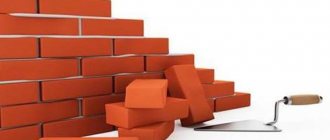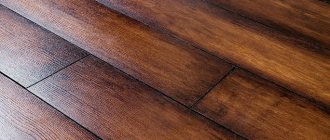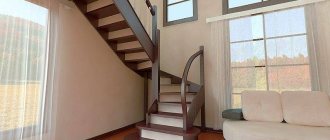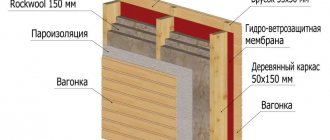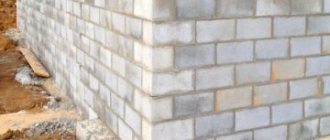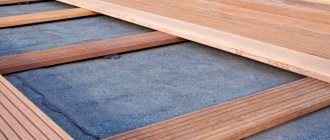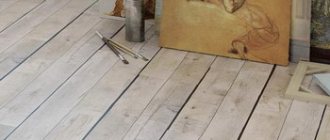To determine how thick a wall to build when building a house, you need to learn how to calculate the thermal conductivity of walls.
This indicator depends on the building materials used and climatic conditions. Standards for wall thickness in the southern and northern regions will differ. If you do not make a calculation before starting construction, it may turn out that the house will be cold and damp in winter, and too humid in summer.
To avoid this, you need to calculate the heat transfer resistance coefficient of the material for building walls and insulation.
What's the best way to proceed?
Today you can do this yourself: make the necessary calculations, find out the optimal materials for the job and install them yourself.
You can prefer to work with a large company, which can, for a fee, make an accurate calculation, select materials and begin their installation.
Of course, if you do everything yourself, there will be no one to make a claim.
In the case of a company, you can complain about poor quality, dishonest work, or when the required effect from the work performed was not achieved.
To calculate the thermal conductivity of a wall, you can use special programs, specialized online calculators that will help you get the numbers you need.
Or you can do it yourself. Many people are mistaken, thinking that they themselves are not able to make calculations, calculate how much thermal insulation will be needed for a room, apartment or house. This is extremely easy to do, because calculating the thickness of the required thermal insulation can be quite simple: manufacturers indicate the thermal conductivity coefficient on all materials.
Label with coefficient
Installation Features
When installing piece parquet, the master must comply with regulatory requirements and all stages of the technological map:
- Parquet is laid only on a previously prepared and leveled base.
Rice. 13. Laying on a leveled base
- It is recommended to lay a backing made of elastic polymer or natural material in front of the device.
Rice. 14. Parquet underlay
- The lamellas are assembled using a special tool.
- If it is necessary to create an ornament, the master needs a design project with a marking scheme.
Rice. 15. Layout design project
- After installation, the parquet must be sanded and covered with a layer of protective compounds. Regardless of the quality of the wood, if moisture gets in, mold and mildew will form on the material.
Rice. 16. Mold on the parquet
- Parquet trimming must be done using high-power power tools to achieve maximum cutting accuracy.
Rice. 17. Trimming elements
- During operation, it is necessary to provide periodic maintenance of the material and maintain optimal temperature and humidity conditions in the room.
Rice. 18. Cleaning parquet
If all requirements are met, the parquet will be used for many years. Before installing the material, you need to choose a company that has been working on the market for a long time, has a staff of qualified craftsmen and has many positive reviews on forums from satisfied customers.
Rice. 19. Processing and varnishing
Rice. 20. Parquet in an old interior
What does the wall thickness depend on?
This indicator is primarily determined by the climate of the region in which the house is being built. The most important indicator in the calculations is the level of resistance to heat transfer. The values of this indicator will vary in different cities. The colder the climate, the higher the required minimum threshold for wall thermal resistance.
Heat transfer resistance is regulated by regulatory documents and has a constant value within each region.
A complete table of the required heat transfer resistance values for cities in the Russian Federation can be downloaded here Thermal resistance table.
Another important factor is the material of the walls. The thermal conductivity of all materials that make up the so-called “pie” is important.
The thermal conductivity values of all possible building materials can be found in the Table of Thermal Conductivity of Materials.
Expanded clay
Now let’s look at how thick the insulation on an expanded clay ceiling should be. This is the most wear-resistant material of all of the above, and at the same time environmentally friendly and inexpensive. It is characterized by high resistance to fire and good water absorption.
If you use expanded clay as ceiling insulation, the thickness should be maximum: 10 cm and above. To create a dense insulating layer, it is better to use a mixture of several types of expanded clay to insulate the ceiling. A 20-centimeter layer insulates heat better than a half-meter thick wooden wall.
Quite often it is used in baths. What thickness should the ceiling insulation be in this case? It all depends on the insulating layer.
The ceiling is first lined with waterproofing material, and then a layer of expanded clay is poured. The thickness of the ceiling insulation in a bathhouse made of blocks in this case will be about 25 cm. Waterproofing material is laid on top of it, just like on mineral wool.
Let's consider what the thickness of the insulation for the ceiling of a cold attic should be.
For the walls of attic structures, it is better to lay expanded clay in large blocks of 20-40 cm. Expanded clay particles are very light, so they will not significantly increase the load and are well suited for insulating roofs and attics. The downside is that for the most effective insulation of the ceiling, the thickness of the roof insulation must be at least half a meter.
We carry out calculations
Calculating wall thickness based on thermal conductivity is an important factor in construction. When designing buildings, the architect calculates the thickness of the walls, but this costs extra money. To save money, you can figure out how to calculate the necessary indicators yourself.
The rate of heat transfer by a material depends on the components included in its composition. The heat transfer resistance must be greater than the minimum value specified in the regulatory document “Thermal insulation of buildings”.
Let's look at how to calculate the thickness of a wall depending on the materials used in construction.
δ is the thickness of the material used to build the wall;
λ is an indicator of specific thermal conductivity, calculated in (m2 °C/W).
When you purchase building materials, the thermal conductivity coefficient must be indicated in the passport.
Parameter values for residential buildings are specified in SNiP II-3-79 and SNiP 02/23/2003.
Acceptable values depending on region
The minimum permissible value of heat conductivity for various regions is indicated in the table:
| № | Thermal conductivity index | Region |
| 1 | 2 m2•°C/W | Crimea |
| 2 | 2.1 m2•°C/W | Sochi |
| 3 | 2.75 m2•°C/W | Rostov-on-Don |
| 4 | 3.14 m2•°C/W | Moscow |
| 5 | 3.18 m2•°C/W | Saint Petersburg |
Each material has its own heat conductivity index. The higher it is, the more heat this material transmits through itself.
Calculation of thermal conductivity of walls: table of thermal resistance of materials
In many cases, when choosing a material for building a house, we do not delve into what the thermal resistance of building materials is, but rely on “folk” methods.
The most popular of them are: “like a neighbor’s”, “like before”, “look how thick the layer is”, and - the crown of art - “it seems like it should be normal”. Well, it’s your home—you decide which method to choose. But to accurately answer the question of whether your home will be warm enough in winter (and cool enough in the summer heat), you need to know the thermal resistance of the wall. Where can you find it out, how to calculate the thermal conductivity of a wall, and how will this help answer your question? Let's take it in order. So, a little theory to define the terms and understand how to calculate the thermal resistance of a wall.
If there is a temperature difference inside the body, then thermal energy moves from the hotter part of the body to the colder part. This type of heat transfer, caused by thermal movements and collisions of molecules, is called thermal conductivity. So, thermal conductivity is a quantitative assessment of the ability of a particular substance to conduct heat. Thermal resistance
– the reciprocal value of thermal conductivity. (It conducts heat well, which means it resists heat poorly. Therefore, it has high thermal conductivity and low thermal resistance). That is, during construction it is better to use materials with low thermal conductivity (high thermal resistance) for better heat retention.
Folgoizol
Folgoizol, or folgopergamine, is a lightweight and highly elastic material for thermal insulation, which is a base made of dense fiberglass covered with aluminum foil.
To insulate ceilings, it is better to use foil insulation of the highest strength; this will extend its service life for decades. The layers of insulation fit tightly to each other, preventing cold from passing through the seams.
Folgoizol practically does not absorb water, but can withstand temperatures up to +125 °C. Dense material with good thermal conductivity. Taking into account such distinctive features, this insulation is well suited for thermal insulation of baths, steam rooms and saunas.
Before deciding how thick the insulation on a foil insulation ceiling should be, you should know the following:
- It is mainly used for thermal insulation of pipes, and it will not save you from frost. It is often used as additional insulation.
- Suitable for latitudes with mild climates.
- The average thickness of the ceiling insulation in this case can be about 1-2 cm.
Individual element thickness
thickness of materials for building walls
When calculating the thickness of a brick wall, you also need to take into account how thick its individual element will be. In modern construction it is common to use the following types:
- single;
- one and a half;
- double.
The most common unit of brick will have the following dimensions - 25 x 1.2 x 6.5 cm. These dimensions have remained unchanged since the first half of the last century, when they were fixed in the relevant documentation. For a one-and-a-half copy, the size will be 25x12x8.8 cm. It would be even better to use a double version for external walls. Its dimensions are 2.5 cm x 12 cm x 13.8 cm.
Styrofoam
Oddly enough, polystyrene foam does not require careful vapor and waterproofing. All this is because the foam itself is already very hygroscopic, and its vapor permeability is 0%.
The second advantage of this simple building material is its thermal insulation properties, the operation of which continues for many years. For example, glass wool does not have such properties, and foam plastic, on the contrary, unlike it, does not cake.
The third advantage of polystyrene foam, many experts consider its unpretentiousness. Insulating the ceiling with foam plastic will not take you much time.
The entire process takes from an hour to several days, depending on the complexity of the work and the territory in which the construction work is being carried out. With such fittings you will not need any professional skills or expensive tools. Even an incompetent or a beginner can cope with such work. Polystyrene foam, as a means of insulation, is more effective than other insulation materials if the installation of the thermal insulation layer is carried out with the same thickness of the material.
The last and important point of the advantages of polystyrene foam can be considered its price. If you purchase it, it will significantly help reduce costs.
Polystyrene foam consists of granules enriched with gas, which are dissolved in a polymer mixture. Thanks to this composition, it has incredibly low density, minimal weight, and high sound and heat insulation properties.
As a ceiling insulation, polystyrene foam is significantly inferior to others: it is noticeably more expensive than mineral wool, it is very brittle and will crumble during installation, and is easily flammable.
How thick should this type of insulation be on the ceiling?
Insulating the ceiling and external frame with foam plastic can significantly reduce heat loss. A 20-centimeter layer of insulation on the ceiling of a house is distinguished by such high heat retention that even a reinforced concrete ceiling several meters thick does not have.
For work, they usually purchase foam plastic no thicker than 3 cm; for insulating walls in a room, a layer 5 cm thick, one to one in size, is suitable. To insulate a cold attic with polystyrene foam, it is necessary to lay the layers as closely as possible to each other. The average thickness of the material layer is 10 cm. To insulate the ceiling of a room, you can use half that thickness.
What thickness should be for a cold attic ceiling with this type of insulation?
To insulate the attic, the sheets are laid in several layers with offset seams at the joints to minimize the possibility of drafts. Usually a standard layer of 10 cm is sufficient.
Calculation of the thermal insulation layer: formulas and examples
To be able to accurately calculate the amount of insulation, it is necessary to find the heat transfer resistance coefficient of all materials in a wall or other area of the house. It depends on the climatic indicators of the area, therefore it is calculated individually using the formula:
tв - indoor temperature indicator, usually 18-22ºC;
tot is the average temperature value;
zot — duration of the heating season, days.
Values for calculation can be found in SNiP 01/23/99.
When calculating the thermal resistance of a structure, it is necessary to add up the indicators of each layer: R=R1+R2+R3, etc. Based on the average indicators for private and multi-storey buildings, approximate values of the coefficients are determined:
- walls - at least 3.5;
- ceiling - from 6.
The thickness of the insulation depends on the building material and its size; the lower the thermal resistance of the wall or roof, the larger the insulation layer should be.
Example: a wall made of sand-lime brick 0.5 m thick, which is insulated with foam plastic.
Rst.=0.5/0.7=0.71 - thermal resistance of the wall
R- Rst.=3.5-0.71=2.79 - value for foam plastic
Having all the data, you can calculate the required insulation layer using the formula: d=Rxk
For foam plastic, thermal conductivity k=0.038
d=2.79×0.038=0.10 m - foam boards 10 cm thick will be required
Using this algorithm, it is easy to calculate the optimal amount of thermal insulation for all areas of the house except the floor. When making calculations regarding base insulation, you must refer to the soil temperature table in your region of residence. It is from this that the data is taken to calculate the GSOP, and then the resistance of each layer and the required value of insulation are calculated.
Sequencing
First of all, you need to choose the building materials that you will use to build the house. After this, we calculate the thermal resistance of the wall according to the scheme described above. The obtained values should be compared with the data in the tables. If they match or are higher, good.
If the value is lower than in the table, then you need to increase the thickness of the insulation or wall and perform the calculation again. If the structure contains an air gap that is ventilated with outside air, then the layers located between the air chamber and the street should not be taken into account.
Tree differs from tree: real and ideal thickness
Thickness of the walls of a solid wood house
When building a house from rounded logs, it is necessary to take into account differences in waves - a diameter of 200 mm at the junction gives 100-120 mm. Accordingly, in bottlenecks the protection drops by 40-50%. Thermal insulation must be calculated based on the characteristics at the joints. The second danger of an array is wood cracks and gaps between the crowns. In the first months (up to a year and a half), the material goes through a stage of intense shrinkage - the wood takes its final shape, the fibers curl and crack. Cracks sometimes reach the center of the log or split the beam into two parts. When cracks and crevices appear, the thermal insulation decreases. If the wall is open (builders recommend abandoning finishing and insulation in the first year), then it will be caulked. In the future, it is recommended to carry out inspections, seal cracks and update the inter-crown thermal insulation every 5-7 years.
Thickness of the walls of a laminated timber house
The situation is more pleasant - the high-tech material is glued together from several pre-dried lamellas. The shape does not change over the years, the multilayer structure protects against deep cracks. As a result, the initial thermal insulation is maintained at the design level. At least, reviews from owners about laminated veneer lumber and reports from GOOD WOOD emergency inspectors do not report problems with deteriorating thermal insulation. Theoretically, the thickness of laminated veneer lumber is not limited, but in most cases the standard thickness is used - 160, 175, 200, 240 mm.
The characteristics of such walls have been tested so thoroughly and in detail that GOOD WOOD specialists have developed a calculator to calculate the monthly heating costs of most typical projects:
When building houses from laminated veneer lumber on a turnkey basis, the calculator helps to estimate costs in advance and consciously select wall parameters, floor characteristics, and window design.
Description of corrugated sheets and compliance with the regulatory framework
For installation on the roof, it is necessary to choose the correct corrugated sheet.
Corrugated material is a rolled product with periodic trapezoidal stiffeners 15–160 mm high for roofing decks, and 8–44 mm for fences. Upon request, we produce types of corrugated sheets for walls with a height of more than 44 mm. The corrugations are placed on the surface with the same pitch.
The operational characteristics of rolled metal products are influenced by the following parameters:
- metal and base thickness;
- thickness of galvanization;
- type of coating used;
- thickness of the polymer layer on the surface;
- waveform and stiffeners.
In production, GOST 19.904 - 1990 is used, which contains a regulatory framework regarding cold-rolled sheets, GOST 30.246 - 1994 with technical conditions for the production of steel sheets with decorative coating for building materials. GOST R 52.146 – 2003 contains standards for the production of hot-dip galvanized sheets with a polymer layer on continuous conveyors.
Advantages and disadvantages of profiled sheets
The corrugated sheet is a finished product that does not require processing before installation in the installation position. Installation is simple, and the length of the strips up to 12 meters allows you to avoid making joints on long slopes.
All types of coated corrugated sheets have positive properties:
- Corrosion protection. The polymer layer on the surface protects against chemical attack and mechanical shock.
- Wide selection of colors and patterns. The layers are made 25 - 20 microns thick, painted in different colors, designs of stone, leather, wood, etc. are made.
- Light weight. Thin sheets of iron are used as a base, and strength is obtained through stiffening ribs and additional grooves.
The disadvantages of corrugated sheets include sound conductivity, this is especially important for the roof. The problem is eliminated by installing sound insulation and organizing air gaps in the roof structure.
Production technology
Types of wall and roofing corrugated sheets
The material is produced from galvanized sheets by cold rolling using bending equipment. In the process, the metal is profiled and the waves are given a square or other shape to increase the rigidity and strength of the profile. The quality of the rolling equipment is important, since during the production process the thin film on the surface can be damaged.
Manufacturing stages:
- galvanizing of steel sheets for corrosion protection;
- passivation of the applied layer to obtain an oxide film;
- priming the surface to increase adhesion;
- painting with polymer compounds, varnishing;
- application of a protective composition.
Galvanized and painted corrugated sheets are produced using the same technology until painting. The polymer layer does not replace galvanizing, it only enhances the protective properties. On a thick film (150 - 200 microns), embossing is performed along the relief of the selected pattern so that the profile can look realistic.
Application area
Galvanized types with different sheet sizes are used as fences and wall fencing. In industry, an inexpensive type of material is used for roofing hangars, assembling large-area canopies, and installing internal partitions. Galvanized sheets last up to 20 – 25 years. Compared to painted ones, this is half as long (40 – 50 years).
Corrugated sheets with polymer coating are used as:
- façade cladding;
- roofing;
- fences;
- self-supporting structures;
- permanent formwork;
- filling between elements of frame buildings.
The material does not load the foundation, so when cladding the walls of the house, reinforcement of the foundation is not required. Corrugated sheets are used for inclined slopes; flat roofs are also made. Strength allows you to withstand the weight of accumulated snow and ice on the surface. Corrugated sheeting saves material for sheathing when constructing slopes with a large slope.


